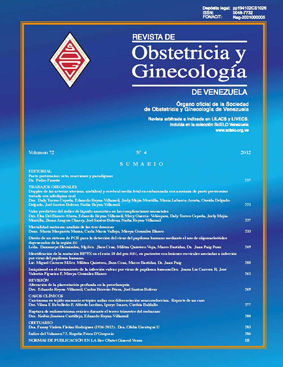Istmocele. Reporte de caso
Keywords:
Istmocele, Dehiscencia de la Cicatriz, DolorPélvico, Isthmocele, Scar Dehiscence, Pelvic PainAbstract
Defects in cesarean scar results from a postoperative complication of the uterine isthmus, also known as an isthmocele. This is a reservoir-like pouch defect on the anterior wall of the uterine isthmus located at the site of a previous cesarean scar. The flow of menstrual blood through the cervix may be slowed by the presence of isthmocele, as the blood may accumulate in the niche and, together with the presence of fibrotic tissue, cause pelvic pain. The removal of the local inflamed tissue improves symptoms and restores fertility. We report the case of a 39-year-old with history of inter-menstrual bleeding, pelvic pain and dysmenorrhea. Images studies revealed a cesarean scar defect connected to a small cavity in the myometrium compatible with an isthmocele. After surgical excision, symptoms resolved. This case highlights the importance surrounding diagnosis, management and benefits of surgical repair of uterine scar defect after cesarean section.
Downloads
References
Masuda H, Uchida H, Maruyama T, Sato K, Sato S, Tanaka M. Successful treatment of atypical cesarean scar defect using endoscopic surgery. BMC Pregnancy Childbirth. 2015; 15: 342. doi: 10.1186/s12884-015-0730-x.
Aimi G, Buggio L, Berlanda N, Vercellini P. Laparoscopic repair of a symptomatic post-cesarean section isthmocele: a video case report. Fertil Steril. 2017; 107(6): e17-e18. doi: 10.1016/j.fertnstert.2017.04.004.
Raimondo G, Grifone G, Raimondo D, Seracchioli R, Scambia G, Masciullo V. Hysteroscopic treatment of symptomatic cesarean-induced isthmocele: a prospective study. J Minim Invasive Gynecol. 2015; 22(2): 297-301. doi: 10.1016/j.jmig.2014.09.011.
Heller DS. Pathologic basis for abnormal uterine bleeding with organic uterine pathologies. Menopause. 2011; 18(4): 412-415. doi: 10.1097/gme.0b013e3181fe6e41.
Pandit SN, Khan RJ. Surgical techniques for performing caesarean section including CS at full dilatation. Best Pract Res Clin Obstet Gynaecol. 2013; 27(2):179-195. doi: 10.1016/j.bpobgyn.2012.12.006.
Kizer S. Frecuencia de la cesárea: factores resaltantes relacionados con su incremento. Gac Med Caracas. 2011; 119 (1): 12 – 21.
Carmona J, D`Alta M, Piñero A, Contreras I, Rozo I. Incidencia e indicación de cesárea en el Hospital Padre Justo Arias de Rubio. Col Med Estado Táchira. 2005; 14(4):23 – 27.
Bamberg C, Hinkson L, Dudenhausen JW, Bujak V, Kalache KD, Henrich W. Longitudinal transvaginal ultrasound evaluation of cesarean scar niche incidence and depth in the first two years after single- or double-layer uterotomy closure: a randomized controlled trial. Acta Obstet Gynecol Scand. 2017; 96(12): 1484-1489. doi: 10.1111/aogs.13213.
Tulandi T, Cohen A. Emerging manifestations of cesarean scar defect in reproductive-aged women. J Minim Invasive Gynecol. 2016; 23(6): 893-902. doi: 10.1016/j.jmig.2016.06.020.
Osser OV, Jokubkiene L, Valentin L. Cesarean section scar defects: agreement between transvaginal sonographic findings with and without saline contrast enhancement. Ultrasound Obstet Gynecol. 2010; 35(1): 75-83. doi: 10.1002/uog.7496.
Singh D, Kaur L. When a cesarean section scar is more than an innocent bystander in a subsequent pregnancy: Ultrasound to the rescue. J Clin Ultrasound. 2017; 45(6): 319-327. doi: 10.1002/jcu.22485.
Urman B, Arslan T, Aksu S, Taskiran C. Laparoscopic repair of cesarean scar defect “isthmocele”. J Minim Invasive Gynecol. 2016; 23(6): 857-8. doi: 10.1016/j.jmig.2016.03.012.
Marotta ML, Donnez J, Squifflet J, Jadoul P, Darii N, Donnez O. Laparoscopic repair of post-cesarean section uterine scar defects diagnosed in nonpregnant women. J Minim Invasive Gynecol. 2013; 20(3): 386-91. doi: 10.1016/j.jmig.2012.12.006.
Florio P, Gubbini G, Marra E, Dores D, Nascetti D, Bruni L, et al. A retrospective case-control study comparing hysteroscopic resection versus hormonal modulation in treating menstrual disorders due to isthmocele. Gynecol Endocrinol. 2011; 27(6): 434-8. doi: 10.3109/09513590.2010.495431.

